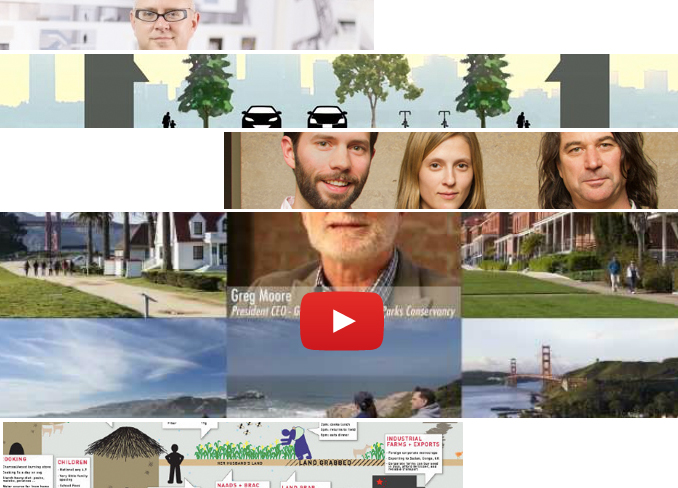 I always love this time of year for its illusion of a fresh start. Like so many of you, I’m looking to 2012 in terms of all the new endeavors that will be debuted. From our book Social Media in Action(which will be out in March) to the projects and events we are working on with clients - a strong start doesn’t necessarily predicate success in the end, but it certainly helps. This past year, I’ve had a good vantage point to two very successful launches that have sparked some new ideas for my own work, so I figure some of you may also find value in a peek behind the scenes.
The two are very different. The first is a new online journal that explores the concept and practice of landscape urbanism – aptly named Landscape Urbanism. The next is a new approach to showing a products’ sustainability by Perkins+Will and Construction Specialties (C/S). One is a grass-roots approach for an entrepreneurial venture and the other a splashy PR opening for well-respected brands.
I always love this time of year for its illusion of a fresh start. Like so many of you, I’m looking to 2012 in terms of all the new endeavors that will be debuted. From our book Social Media in Action(which will be out in March) to the projects and events we are working on with clients - a strong start doesn’t necessarily predicate success in the end, but it certainly helps. This past year, I’ve had a good vantage point to two very successful launches that have sparked some new ideas for my own work, so I figure some of you may also find value in a peek behind the scenes.
The two are very different. The first is a new online journal that explores the concept and practice of landscape urbanism – aptly named Landscape Urbanism. The next is a new approach to showing a products’ sustainability by Perkins+Will and Construction Specialties (C/S). One is a grass-roots approach for an entrepreneurial venture and the other a splashy PR opening for well-respected brands.
Landscape Urbanism
“We wanted to tell people what we were doing even though we weren’t finished yet,” explains Landscape Urbanism Founder Sarah Peck. In March of 2011, she launched a beta, “coming soon” site that conveyed a simple “About Us” message, let people know how they could participate and asked them to sign up for email updates. “We kept it really simple: a visual page with two ways that people could interact: find us online or sign up to be notified of the site’s launch." At the same time as the beta launch, Sarah also began the @LandUrbanism Twitter account and a Facebook page -- and then she begged friends and family to like the page, since pages need 25 fans to secure its name. Immediately Sarah began positioning the journal by sharing content related to landscape urbanism and posting periodic updates on the website. By the time the site launched in September she had accumulated more than 300 Twitter followers and 250 Facebook fans.
 Over the next few months, Sarah teamed with Editors Eliza Valk, Nicholas Pevzner, Stephanie Carlisle and Julie Canter and reached out to every corner of their networks for contributors from academia, leaders of reputable professional practices large and small as well as entrepreneurs behind other networks and movements that could offer useful insights to her audience. When the site launched, they had a good first issue and a strong line-up for the second issue, which was just released last month. Five days after the site went live, Sarah invited the almost 500 email subscribers to visit the site.
Over the next few months, Sarah teamed with Editors Eliza Valk, Nicholas Pevzner, Stephanie Carlisle and Julie Canter and reached out to every corner of their networks for contributors from academia, leaders of reputable professional practices large and small as well as entrepreneurs behind other networks and movements that could offer useful insights to her audience. When the site launched, they had a good first issue and a strong line-up for the second issue, which was just released last month. Five days after the site went live, Sarah invited the almost 500 email subscribers to visit the site.
With a new issue each quarter, Sarah created a framework that would support frequent updates. This keeps the site fresh for return visitors and helps with search engine optimization. Landscape Urbanism has three ways for readers to get information.
- Essays – released collectively as a theme-based, quarterly issues
- Strategies – visual representations of over 30 built and unbuilt projects from students and professionals, with weekly additions
- Blog— content contributed by the community with new posts each week
To promote each issue, Sarah and Eliza use Hootsuite to schedule tweets promoting one essay each week and Facebook updates to promote the posts with the most compelling images. “I typically schedule the tweets and updates all at once, on a Sunday. Once everything is scheduled, I’m free to use Twitter and Facebook to look for posts that inspire me and that our audience will also be interested in – to engage or reshare content from other sources like Sustainable Cities or Next American City”, says Sarah. “If I find it interesting or good, it’s an indicator that others will too.”
Organic growth—especially when the social web is involved—takes time. By starting the Landscape Urbanism presence well before the first round of content was ready, Sarah began her journal with a healthy readership. Lots of outside contributors also gives her an extra bump of exposure as each author usually makes some effort to share what they’ve written with their own network. In the end it’s the ability of any site to stick with it that will determine success.
Transparency Label
 C/S and Perkins+Will recognized the need for the building industry to be as responsible to the consumer as the food industry is, so C/S and Perkins+Will teamed up to create a label that details the complete make-up of a product. The idea is a very good one, but done in isolation it doesn’t make much progress toward transforming industry practices. The firms saw this announcement as an opportunity to lead the industry in a broader change.
C/S and Perkins+Will recognized the need for the building industry to be as responsible to the consumer as the food industry is, so C/S and Perkins+Will teamed up to create a label that details the complete make-up of a product. The idea is a very good one, but done in isolation it doesn’t make much progress toward transforming industry practices. The firms saw this announcement as an opportunity to lead the industry in a broader change.
They needed to get the word out about the label – not to the public, but to other green-minded product companies and design industry professionals. But where could they find lots of these people in one place? The answer was clear, GreenBuild 2011.
Attended heavily by industry leaders and press, the venue allowed C/S and Perkins+Will to make an event of their announcement. They hired Jessica Appelgren of Blue Practice PR to pre-release the announcement to key reporters that cover green products and design in advance of the conference with the understanding that they would not publish anything until the press release was distributed on October 5. As a result of early outreach, the label generated a string of articles on the day of the announcement in high profile blogs on Fast Company, Huffington Post and Forbes and in the days following in Contract, GreenSource, Inhabitat and GreenBiz.
C/S also showed their first label for the MBDC Cradle to Cradle CertifiedCM Entrance Flooring product PediTred® G4 and launched a companion website, developed in partnership with Perkins+Will.  The label is symbiotic to the "Precautionary List" developed by Perkins+Will in 2009, a list that highlights chemicals listed by government agencies as having negative health issues and the classes of building materials where they might commonly be found. In November, Perkins+Will launched amicro-site devoted to transparency that incorporates the 2009 Precautionary List.
The label is symbiotic to the "Precautionary List" developed by Perkins+Will in 2009, a list that highlights chemicals listed by government agencies as having negative health issues and the classes of building materials where they might commonly be found. In November, Perkins+Will launched amicro-site devoted to transparency that incorporates the 2009 Precautionary List.
Social Media played a large role in the announcement’s success. At a large conference like GreenBuild, Twitter topics linked to the conference hashtag have a great influence over the conversations in the halls. Blue Practice ensured that the social media managers from both C/S and Perkins+Will were prepared to tweet links to the transparency label articles when they hit on the first day of the conference by sending the links to the teams with suggestions for the 140 characters of accompanying text. Every time a new piece emerged online, the links were tweeted by multiple sources referencing the GreenBuild hashtag, creating a metaconversation about the role of transparency in green building at the conference.
Now that the first label has been unveiled on one product, C/S plans to roll it out to the company’s entire entrance flooring division product line in 2012. Perkins+Will continues to push for an industry transformation through transparency and offers support to other companies interested in adopting a label.
A successful launch is ultimately about finding the right audience. Landscape Urbanism planted seeds months in advance to create a grassroots following and an organically grow its readership. C/S and Perkins+Will targeted the influencers. Reaching out to these handpicked individuals weeks before revealing their label to their intended audience. As a result, the new label reached a significantly broader green-minded audience than those who attended GreenBuild. No matter what you are launching in 2012, don't forget about social media. It's an important tool to add to your marketing and communications mix. It can’t replace direct contact with members of your personal network, big industry events or traditional PR, but its ability to amplify your efforts makes it an important part of any strategy.





 Over the next few months, Sarah teamed with Editors Eliza Valk, Nicholas Pevzner, Stephanie Carlisle and Julie Canter and reached out to every corner of their networks for contributors from academia, leaders of reputable professional practices large and small as well as entrepreneurs behind other networks and movements that could offer useful insights to her audience. When the site launched, they had a good first issue and a strong line-up for the second issue, which was just released last month. Five days after the site went live, Sarah invited the almost 500 email subscribers to visit the site.
Over the next few months, Sarah teamed with Editors Eliza Valk, Nicholas Pevzner, Stephanie Carlisle and Julie Canter and reached out to every corner of their networks for contributors from academia, leaders of reputable professional practices large and small as well as entrepreneurs behind other networks and movements that could offer useful insights to her audience. When the site launched, they had a good first issue and a strong line-up for the second issue, which was just released last month. Five days after the site went live, Sarah invited the almost 500 email subscribers to visit the site.
 The label is symbiotic to the "Precautionary List" developed by Perkins+Will in 2009, a list that highlights chemicals listed by government agencies as having negative health issues and the classes of building materials where they might commonly be found. In November, Perkins+Will launched a
The label is symbiotic to the "Precautionary List" developed by Perkins+Will in 2009, a list that highlights chemicals listed by government agencies as having negative health issues and the classes of building materials where they might commonly be found. In November, Perkins+Will launched a